Table of Contents
- Introduction
- Editor’s Choice
- Countries with the Highest Fertility Rates
- Adolescent Fertility Rate Worldwide
- Countries with Highest Adolescent Birth Rate Worldwide
- Assumed Teen Birth Rate vs. Reality
- Teenage Pregnancy in North America Statistics
- Teenage Pregnancy in Africa Statistics
- Teenage Pregnancy in Asia-Pacific Statistics
- Teenage Pregnancy in Europe Statistics
- Teenage Pregnancy in Latin America and the Caribbean Statistics
- Demographic Insights
- Abortions Among Teenage Girls
- Birth Control Methods Deployed
- Teenage Pregnancy, Births, and Abortions Averted by Public Clinics Statistics
- Key Investments
- Initiatives to Combat Teenage Pregnancy Statistics
- Teenage Pregnancy Regulations and Statistics
- Recent Development
- Conclusion
- FAQs
Introduction
Teenage Pregnancy Statistics: Teenage pregnancy, occurring in females aged 13 to 19, presents significant public health and socio-economic challenges.
It is influenced by factors such as lack of sexual education, socio-economic disadvantages, and family dynamics.
Teenage mothers face higher risks of health complications, and their children may experience low birth weight and developmental delays.
The impact extends to educational and economic outcomes, with affected adolescents often struggling to complete their education and secure stable employment.
Preventive measures include comprehensive sex education, access to contraception, and robust support systems.
Effective strategies require community engagement and supportive policies to address and mitigate these challenges.
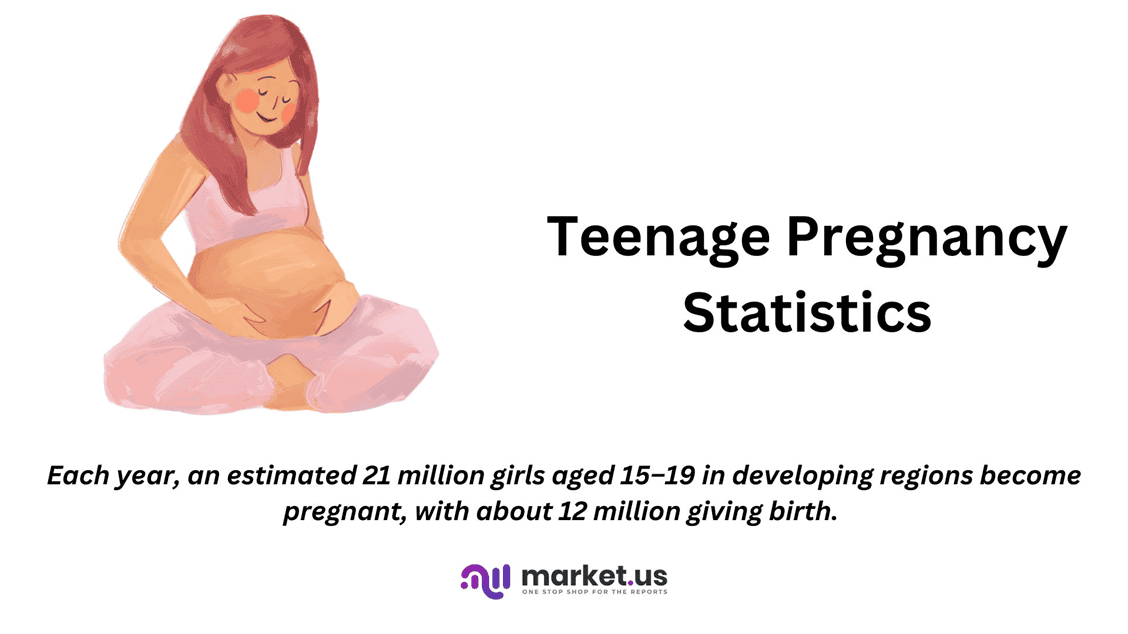
Editor’s Choice
- Digital Pregnancy Test Kits Market Size is projected to reach approximately USD 275.1 million by 2033
- As of 2021, adolescent fertility rates varied significantly by region across the globe. West and Central Africa had the highest rate, with 107 births per 1,000 girls aged 15-19.
- Between 1991 and 2022, the birth rate among U.S. teenagers aged 15-19 years experienced a dramatic decline.
- In 2021, adolescent fertility rates across African countries revealed significant regional disparities. Niger reported the highest rate on the continent, with 170.5 births per 1,000 women aged 15-19 years.
- In 2022, the adolescent fertility rates across countries in the Asia-Pacific region showed considerable variation, with Afghanistan reporting the highest rate at 79.74 births per 1,000 women aged 15-19 years.
- In 2007, the overall teen birth rate was 41.5 births per 1,000 women, with significant variations by race and ethnicity. Non-Hispanic white teens had a birth rate of 27.2, while non-Hispanic Black teens had a much higher rate of 62.
- As of March 2024, public opinion in South Korea regarding the acceptability of abortion in cases of teenage pregnancies varied by the stage of pregnancy. Approximately 16% of respondents believed that abortion was not acceptable under any circumstances.
- As of July 2019, a survey of young adult respondents in China revealed that condoms were the most commonly used contraceptive method, with 66.7% of respondents utilizing them to prevent pregnancy.
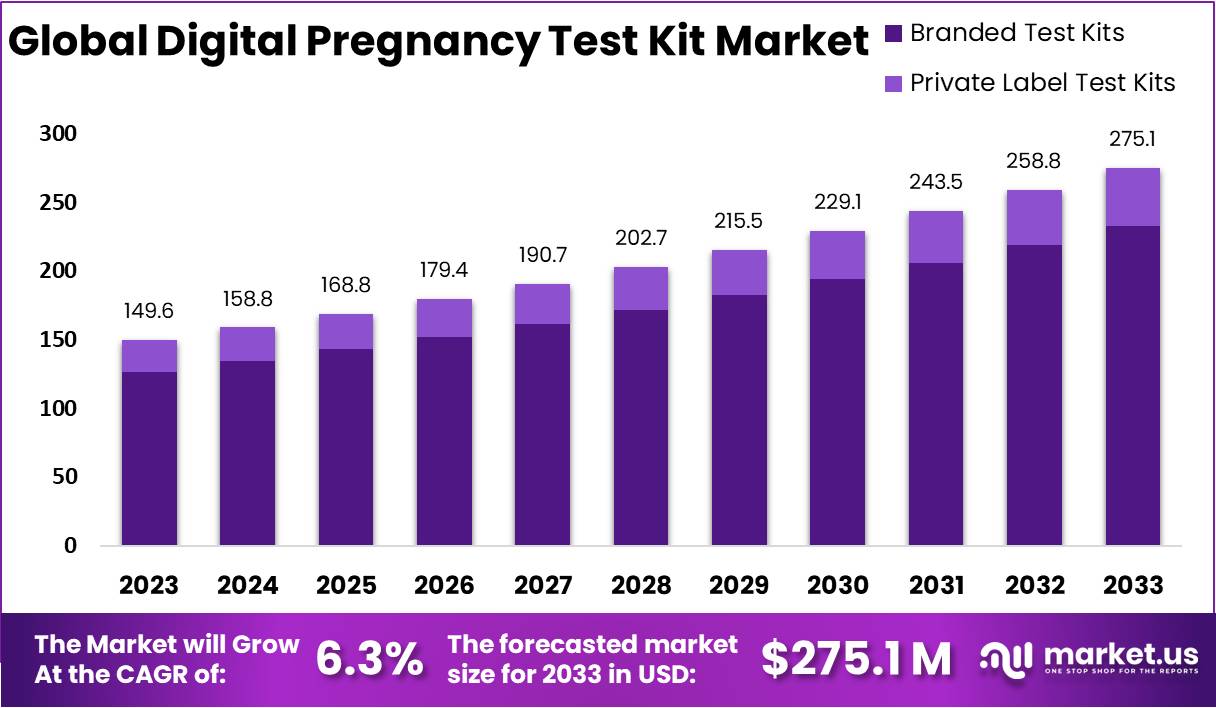
Countries with the Highest Fertility Rates
- In 2024, the countries with the highest fertility rates. Measured as the average number of children per woman, were predominantly located in Africa.
- Niger ranked the highest, with a fertility rate of 6.6 children per woman.
- Chad followed with a rate of 6.03, while the Democratic Republic of Congo and Somalia reported similar rates of 5.99 and 5.98, respectively.
- The Central African Republic had a fertility rate of 5.74, and Mali recorded 5.71.
- Angola had a slightly lower rate of 5.04, with Nigeria close behind at 4.99.
- Burundi reported a rate of 4.78, followed by Benin at 4.74 and Tanzania at 4.51.
- Burkina Faso, Gambia, and Mozambique had fertility rates of 4.47, 4.41, and 4.4, respectively.
- Afghanistan had a fertility rate of 4.29, while Sudan reported 4.25.
- Uganda, Cameroon, and Côte d’Ivoire all had similar fertility rates, around 4.23, and Mauritania recorded 4.19.
- These figures highlight the persistence of high fertility rates in many African and select Asian countries, reflecting ongoing demographic trends in these regions.
(Source: Statista)
Take advantage of our unbeatable offer - buy now!


Adolescent Fertility Rate Worldwide
- As of 2021, adolescent fertility rates varied significantly by region across the globe.
- West and Central Africa had the highest rate, with 107 births per 1,000 girls aged 15-19.
- East and Southern Africa followed closely, reporting a rate of 96.
- In Latin America and the Caribbean, the adolescent birth rate was 53 per 1,000 girls. While the Middle East and North Africa recorded a significantly lower rate of 35.
- South Asia reported an adolescent fertility rate of 29 per 1,000, and East Asia and the Pacific had a rate of 20.
- In North America, the adolescent birth rate was much lower at 15. While Europe and Central Asia had the lowest regional rate at 14 births per 1,000 girls.
- These figures illustrate the wide disparities in adolescent fertility rates across different global regions.
(Source: Statista)

Countries with Highest Adolescent Birth Rate Worldwide
- In 2022, the adolescent fertility rate, measured as the number of births per 1,000 women aged 15-19 years, was notably high across several African nations.
- Niger recorded the highest rate at 168 births per 1,000 adolescent women, followed closely by Mozambique with a rate of 165 and the Central African Republic at 159.
- Mali also exhibited a high adolescent birth rate of 148, while Equatorial Guinea, Angola, and Chad each reported rates of 136.
- Tanzania followed with 123 births per 1,000 adolescent women, and Liberia registered a rate of 122.
- In Madagascar, the adolescent fertility rate was 118, while both Malawi and Zambia reported similar rates of 117 and 116, respectively.
- Somalia also saw a rate of 116, while Guinea’s rate was slightly lower at 112.
- Burkina Faso and Cameroon each had a rate of 109, with the Democratic Republic of Congo (Congo, Dem. Rep.) at 107 and Uganda at 106.
- Finally, Côte d’Ivoire and the Republic of Congo (Congo, Rep.) reported adolescent fertility rates of 103 and 101, respectively.
- These figures highlight the significant variations in adolescent birth rates across the African continent, with many countries experiencing high fertility rates among young women.
(Source: Statista)

Assumed Teen Birth Rate vs. Reality
- In 2017, significant gaps existed between the actual adolescent birth rates (teens aged 15 to 19 who gave birth) and public perceptions across various countries.
- In Brazil, the actual birth rate was 6.70%, yet respondents believed it to be as high as 48%. Similarly, in Argentina, while the actual rate stood at 6.40%, the perceived rate was 37%.
- The Philippines saw a perception of 40%, far higher than the actual 6.30%, while in Mexico, the public estimated the rate at 45%, compared to the actual figure of 6.20%.
- In countries like Indonesia and Colombia, the actual birth rates were 4.90%, yet the perceived rates were 30% and 44%, respectively. Peru and Chile had actual rates of 4.80%, but the public guessed 39% and 35%.
- South Africa, with an actual rate of 4.40%, was also overestimated by the public at 44%. Turkey and India both had actual adolescent birth rates of 2.70% and 2.30%, while public perception was 26% for both countries.
- Other countries showed similar discrepancies: New Zealand and Russia had actual rates of 2.30%, while public guesses were 19% and 20%, respectively. In the USA, where the actual rate was 2.10%, the perceived rate was 24%. Serbia and Hungary had actual rates of 1.90% and 1.80%, yet the public estimates were 15% and 18%.
- Malaysia, Great Britain, and Poland had actual birth rates of 1.40%, 1.40%, and 1.30%, but public guesses stood at 27%, 19%, and 16%, respectively. In Australia, the actual rate was 1.20%, while public perception was 18%.
More Insights
- France and Canada both had actual rates of 0.90%, but public guesses were 18% and 20%. Other notable countries include Israel (actual: 0.90%, guessed: 11%), Spain (actual: 0.80%, guessed: 15%), and China (actual: 0.70%, guessed: 12%).
- In European nations like Italy and Germany, the actual birth rates were 0.60%, but the public estimated them at 17% and 16%, respectively.
- Countries like Norway and Sweden saw actual rates of 0.60%, with perceived rates of 8% and 11%. Singapore’s actual rate was 0.40%, yet the public thought it to be 11%, similar to the Netherlands (0.40%, guessed: 12%).
- Japan and South Korea both had very low actual adolescent birth rates at 0.40% and 0.20%, while public perceptions were much higher, with Japan guessed at 27% and South Korea at 8%. Hong Kong also had a low actual rate of 0.30%, but it was overestimated at 10%.
- These data illustrate a global trend where the public tends to overestimate adolescent birth rates, particularly in countries with lower actual rates, indicating a significant gap in public understanding of fertility trends.
(Source: Statista)

Teenage Pregnancy in North America Statistics
United States Teenage Pregnancy Statistics
- Between 1991 and 2022, the birth rate among U.S. teenagers aged 15-19 years experienced a dramatic decline.
- In 1991, the birth rate stood at 61.8 births per 1,000 women in this age group. This rate steadily decreased over the following years, reaching 60.3 in 1992, 59 in 1993, and 58.2 in 1994.
- By 1995, the rate had fallen to 56 and continued to decline to 53.5 in 1996 and 51.3 in 1997. This downward trend persisted, with the birth rate dropping to 50.3 in 1998 and 48.8 in 1999. By the turn of the century in 2000, the birth rate had fallen further to 47.7.
- The early 2000s saw continued declines, with rates of 45 in 2001, 42.6 in 2002, 41.1 in 2003, and 40.5 in 2004.
- The decline slowed in 2005 when the rate reached 39.7, before a slight increase in 2006 (41.1) and 2007 (41.5). By 2008, the rate had dropped again to 40.2 and continued decreasing to 37.9 in 2009.
- From 2010 onward, the decline accelerated, with the rate falling to 34.2 in 2010, 31.3 in 2011, and 29.4 in 2012.
- By 2013, the rate had dropped to 26.5, continuing its sharp decline through 2014 (24.2), 2015 (22.3), 2016 (20.3), 2017 (18.8), and 2018 (17.4).
- By 2019, the rate had dropped to 16.7, further decreasing to 15 in 2020, 13.9 in 2021, and finally reaching a historic low of 13.6 in 2022.
- This sustained reduction over three decades reflects changing social, cultural, and policy factors that have contributed to the decrease in teenage pregnancies in the United States.
(Source: Statista)

Top U.S. States Based on Teenage Pregnancy Rate Statistics
- In 2017, the District of Columbia had the highest teenage pregnancy rate in the United States, with 47 pregnancies per 1,000 women aged 15-19.
- Arkansas followed with a rate of 44, while Mississippi recorded 43 pregnancies per 1,000 teenage women.
- Both New Mexico and Louisiana reported a rate of 41, making them tied for fourth place.
- Oklahoma had a slightly lower rate of 40, followed by Kentucky and Texas, each with a rate of 39.
- Alabama reported 38 pregnancies per 1,000 teenage women, while both West Virginia and Tennessee recorded rates of 37.
- These figures highlight the regions with the highest incidence of teenage pregnancies in the country in 2017.
(Source: Statista)

Canada Teenage Pregnancy Statistics
- The fertility rate among Canadian females aged 15 to 19 years experienced a consistent decline from 2014 to 2022.
- In 2014, the fertility rate was 10.4 births per 1,000 females in this age group.
- By 2015, this figure had decreased to 9.5, and the downward trend continued in 2016, with the rate falling to 8.5.
- The fertility rate further dropped to 7.8 in 2017 and to 6.7 in 2018.
- This decline persisted through 2019, when the rate stood at 6.2, and continued in 2020 with a reduction to 5.7.
- The fertility rate reached 5.1 in 2021 and then further declined to 4.4 in 2022, marking the lowest point in the recorded period.
- These figures reflect a steady reduction in adolescent fertility rates over the years, indicating significant shifts in social behavior, access to reproductive health services, and education in Canada.
(Source: Statista)
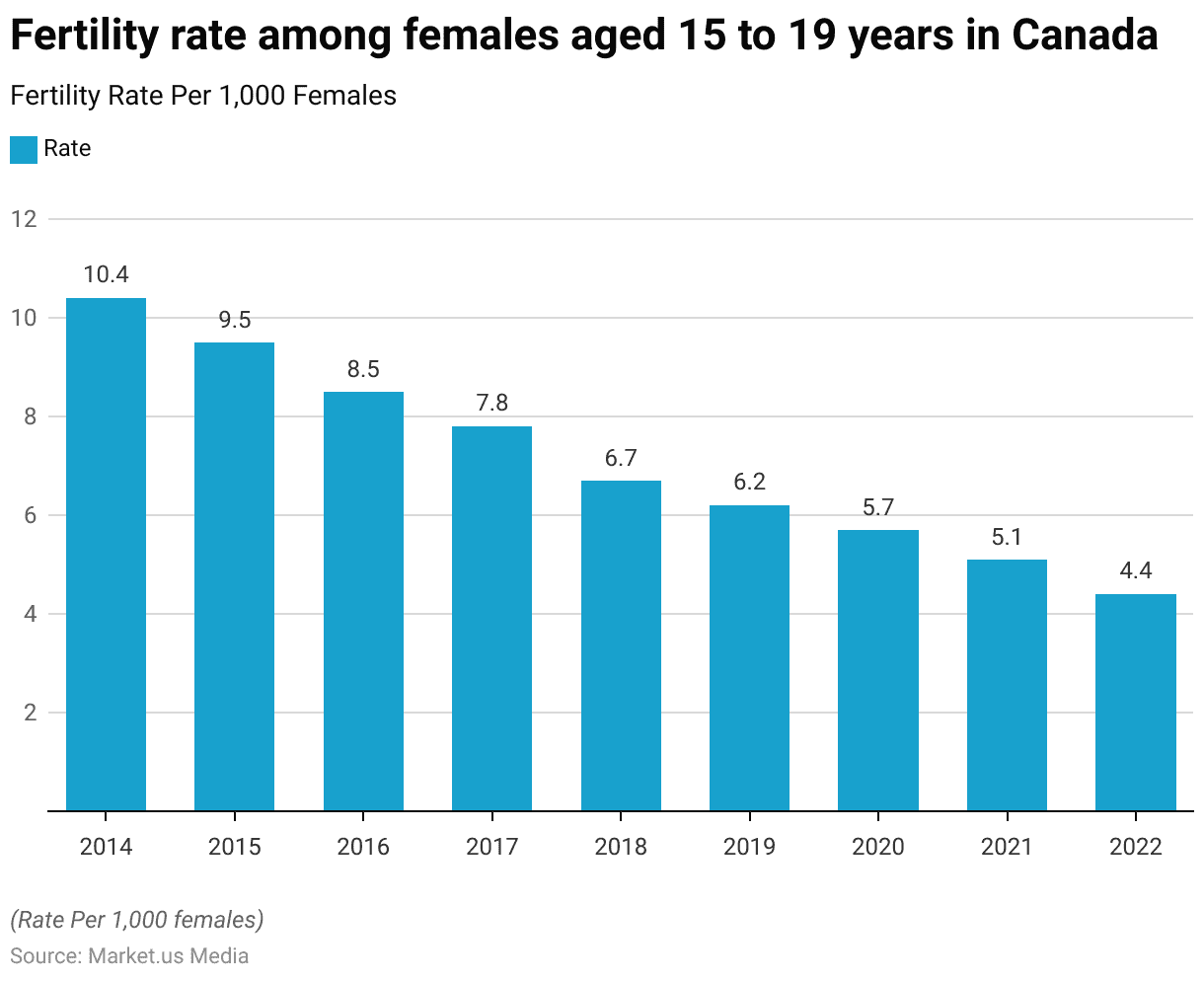
Teenage Pregnancy in Africa Statistics
Adolescent Fertility Rate in Africa – By Country
- In 2021, adolescent fertility rates across African countries revealed significant regional disparities. Niger reported the highest rate on the continent, with 170.5 births per 1,000 women aged 15-19 years.
- Mozambique followed closely with a rate of 165.8, while the Central African Republic recorded 160.5 births per 1,000 adolescent women. Mali reported a rate of 150.1, and Equatorial Guinea had 139.7 births per 1,000 women in this age group.
- Angola, Chad, and Tanzania also exhibited high adolescent birth rates, at 138.4, 138.3, and 123.7, respectively. Liberia and Madagascar had slightly lower rates, with 123.4 and 119.4, respectively. Somalia and Malawi both had rates around 118, while Zambia registered 117.
- Countries such as Guinea, Burkina Faso, and Cameroon had adolescent fertility rates above 110 per 1,000, while the Democratic Republic of the Congo recorded 109. Uganda, Côte d’Ivoire, and the Republic of the Congo reported adolescent birth rates between 103.6 and 107.9.
- Nigeria and Sierra Leone saw rates just above 100, while South Sudan and Zimbabwe had rates of 99.2 and 94.3, respectively.
More Insights
- Several other countries had adolescent fertility rates below 100 per 1,000. Benin reported 92.3, Gabon 91.2, and Lesotho 89.6. Sudan and Sao Tome and Principe exhibited rates of 79.9 and 79.4, while Mauritania and Togo recorded 78 and 77.9, respectively.
- Eswatini, Ethiopia, and Senegal all saw adolescent birth rates below 70 per 1,000, with Eswatini at 69.9, Ethiopia at 69.2, and Senegal at 66.5. Namibia, Eritrea, Ghana, and Kenya reported adolescent fertility rates between 64.2 and 64.9.
- Further south, South Africa had a comparatively low adolescent fertility rate of 61.2, while countries like Comoros (58.2) and Cabo Verde (55.2) saw moderate rates. Burundi and Seychelles each had rates around 53 per 1,000, while Botswana’s rate stood at 49.3. Egypt recorded a rate of 44.8, and Rwanda saw a significant drop, with a fertility rate of 32.4.
- Morocco (25.9), Mauritius (24.6), and Djibouti (22.7) reported even lower adolescent birth rates. North African countries Algeria, Libya, and Tunisia recorded the lowest rates, at 11.7, 6.9, and 6.7, respectively.
- These figures highlight the stark contrasts in adolescent fertility rates across Africa, with some countries facing notably higher rates, particularly in sub-Saharan regions. In comparison, Northern African nations show much lower fertility rates among adolescents.
(Source: Statista)

Adolescent Fertility Rate in Sub-Saharan Africa
- Between 2012 and 2022, the adolescent fertility rate in Sub-Saharan Africa experienced a gradual decline.
- In 2012, the region recorded 115.86 births per 1,000 women aged 15-19 years.
- By 2013, this figure had decreased slightly to 114.79, continuing to drop to 113.5 in 2014.
- The downward trend persisted through 2015, with the fertility rate falling to 110.35 and then further to 107.28 in 2016.
- The region saw continued reductions in subsequent years, with the rate reaching 104.92 in 2017, followed by a slight decrease to 103.68 in 2018.
- By 2019, the adolescent fertility rate had dropped to 102.98, and the trend continued through 2020, with the rate falling to 101.51.
- In 2021, the fertility rate stood at 100.37, and in 2022, the figure dropped below 100 for the first time in the recorded period, reaching 98.72 births per 1,000 women aged 15-19 years.
- This steady decline reflects a combination of factors, including improved access to reproductive health services, and education, and changing social dynamics across the region.
(Source: Statista)

Teenage Pregnancy in Asia-Pacific Statistics
Adolescent Fertility Rate in the Asia-Pacific Region – By Country/Territory
- In 2022, the adolescent fertility rates across countries in the Asia-Pacific region showed considerable variation, with Afghanistan reporting the highest rate at 79.74 births per 1,000 women aged 15-19 years.
- Bangladesh followed with a rate of 73.35, while Laos recorded a fertility rate of 71.78. Nepal had a relatively high rate of 63.36, and Papua New Guinea registered 54.34 births per 1,000 adolescent women.
- Other countries with notable adolescent fertility rates included the Philippines (48.06), Cambodia (45.66), and Pakistan (41.21). Vietnam reported a rate of 34.99, and Timor-Leste stood at 33.27. Indonesia and Myanmar had similar rates of 32.94 and 32.76, respectively, while Thailand recorded a slightly lower rate of 31.59.
- Mongolia’s adolescent fertility rate was 25.03, and Bhutan’s was 18.48. India, the region’s most populous country, had a lower adolescent fertility rate of 16.3, while Sri Lanka reported 15.36. New Zealand had a rate of 11.8, and China followed closely at 11.15.
- Several countries in the region recorded significantly lower adolescent fertility rates, including Brunei (9.52), Malaysia (9.13), and Australia (7.73). The Maldives reported a rate of 6.81, while Japan had a notably low rate of 2.81. Macao (2.66),
- Singapore (2.46), North Korea (2.45), and South Korea (2.11) also exhibited low adolescent fertility rates. Hong Kong reported the lowest rate in the region, with just 1.57 births per 1,000 women aged 15-19.
- These figures highlight the diverse fertility trends across the Asia-Pacific region, reflecting differences in socio-economic conditions, access to healthcare, and cultural practices.
(Source: Statista)

China
- From 2012 to 2022, the fertility rate among Chinese adolescents aged 15 to 19 years steadily declined, though with minor fluctuations.
- In 2012, the fertility rate stood at 16.26 births per 1,000 women, and it slightly decreased to 16.01 in 2013.
- The year 2014 saw a minor uptick, with the rate rising to 16.39.
- However, by 2015, the rate had fallen to 15.33, followed by a continued decline to 15.28 in 2016 and 14.9 in 2017.
- This downward trend accelerated in subsequent years, with the adolescent fertility rate dropping to 13.32 in 2018 and further to 12.94 in 2019.
- The rate continued to decrease in 2020, reaching 11.73 births per 1,000 women.
- By 2021, it had fallen to 11.05, and in 2022, it stood at 11.15.
- The steady decline over the decade reflects changing societal norms, improved access to reproductive health services, and demographic shifts within China.
(Source: Statista)
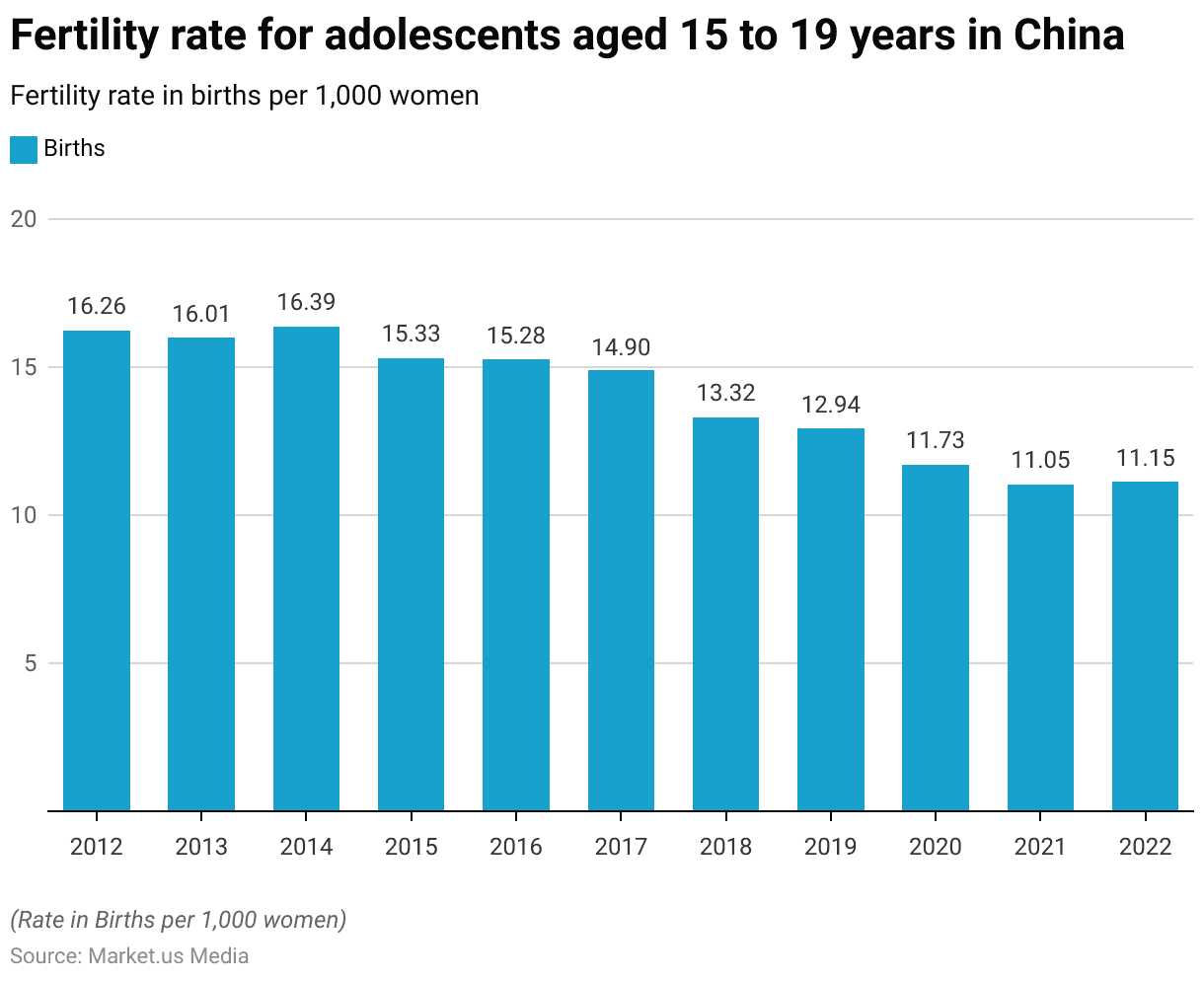
Indonesia
- Between 2013 and 2022, Indonesia experienced a consistent decline in adolescent fertility rates, measured as births per 1,000 women aged 15 to 19 years.
- In 2013, the fertility rate was 43.22 births per 1,000 adolescent women.
- This rate steadily decreased over the following years, reaching 40.8 in 2014 and 38.93 in 2015.
- The downward trend continued through 2016 and 2017, with the rates dropping to 36.62 and 36.01, respectively.
- By 2018, the adolescent fertility rate had fallen further to 35.29, and it continued to decline through 2019, reaching 34.87.
- This trend persisted in 2020 when the rate decreased to 34.48, and in 2021, the rate further dropped to 33.93.
- By 2022, the adolescent fertility rate stood at 32.94 births per 1,000 women aged 15 to 19 years.
- This steady decline reflects ongoing efforts to reduce teenage pregnancies in Indonesia through improved access to reproductive health services and educational initiatives aimed at raising awareness about family planning and sexual health.
(Source: Statista)
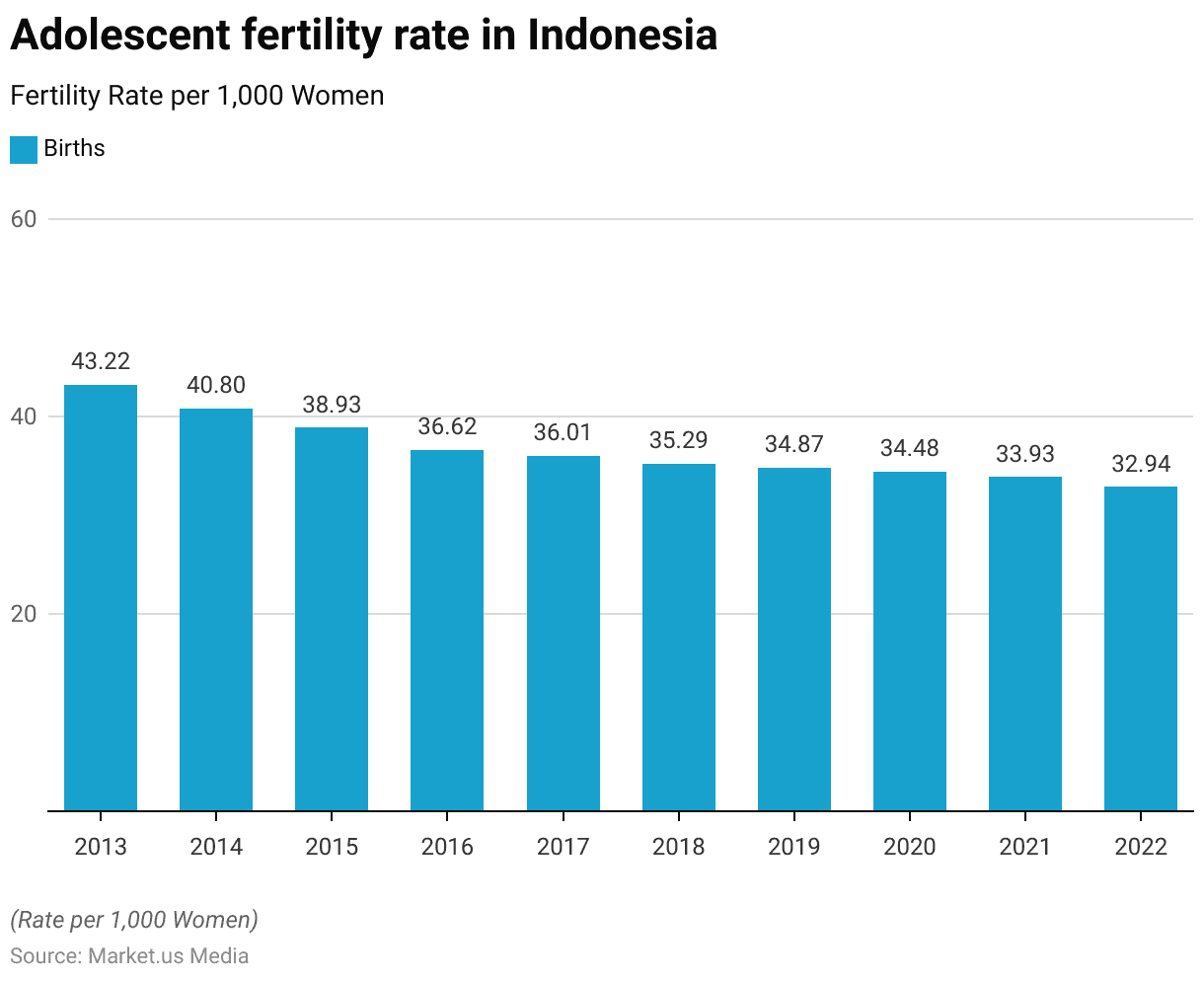
Teenage Pregnancy in Europe Statistics
Adolescent Fertility Rate in Europe – By Country
- In 2019, adolescent fertility rates across Europe varied significantly, with Georgia recording the highest rate at 44 births per 1,000 women aged 15-19 years.
- Bulgaria followed with 38.8, and Romania reported a rate of 34.9. Slovakia and Hungary had relatively high rates of 26.2 and 24.6, respectively, while Ukraine registered 22.3 births per 1,000 adolescent women. Moldova reported a fertility rate of 21.9, and Albania had a rate of 19.5.
- Several countries in the region reported moderate fertility rates. Latvia registered 15.4, followed by North Macedonia at 14.6, Serbia at 13.6, and Belarus at 13. Malta and Czechia both reported rates of 12.1 and 11.9, respectively, with the United Kingdom also recording 11.9 births per 1,000 women in this age group.
- Adolescent fertility rates were generally lower in other European nations. Poland had a rate of 9.8, Lithuania 9.6, and the European Union overall recorded a rate of 8.7. Montenegro reported 8.2, while Croatia had a rate of 7.8. Germany and Portugal both reported 7.6 births per 1,000 adolescent women, while Spain recorded a slightly lower rate of 7.3.
- Countries like Austria and Greece both had rates of 6.7, while Ireland reported 6.6 and Estonia 6.5. Iceland and Finland registered 5.5, and Sweden reported 5.2 births per 1,000 adolescent women. Norway had a fertility rate of 5.1, and Italy recorded a rate of 5.
- At the lower end of the spectrum, France reported a rate of 4.7, Belgium and Luxembourg both had 4.5, and Cyprus recorded 4.3. Denmark had a fertility rate of 4.2, while the Netherlands reported 3.6 and Slovenia 3.5. Switzerland had the lowest adolescent fertility rate in Europe, with just 2.5 births per 1,000 women aged 15-19.
(Source: Statista)
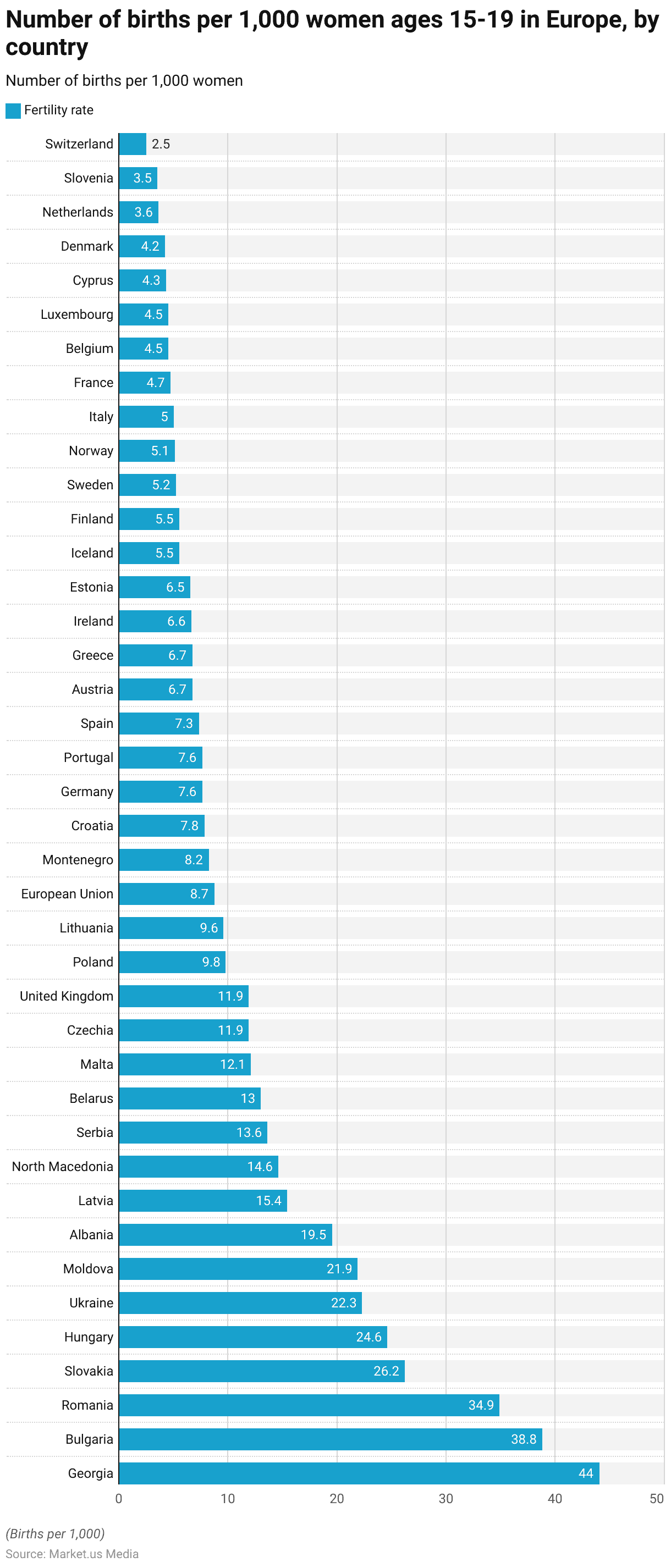
Share of Births to Teenage Mothers in Europe – By Country
- In 2021, the share of live births to mothers under the age of 20 varied significantly across Europe.
- Bulgaria reported the highest proportion, with 9.99% of live births attributed to adolescent mothers. Slovakia followed with 5.93%, and Georgia reported 5.17%. Hungary had a share of 4.89%, while Albania, North Macedonia, and Serbia reported adolescent birth shares of 4.03%, 3.96%, and 3.72%, respectively. Turkey’s share stood at 3.64%, and Russia reported 3.49%.
- Countries like Armenia, Greece, and Belarus had shares ranging from 2.85% to 2.69%, while the United Kingdom saw 2.60% of its live births come from mothers under 20. Latvia (2.53%), Moldova (2.47%), and Montenegro (2.47%) reported similar figures, while Malta and Portugal had shares of 2.43% and 2.09%, respectively. Lithuania and Poland saw 1.80% and 1.79%, and Croatia reported 1.75%, closely followed by Czechia with 1.74%.
More Insights
- In Western Europe, Spain’s share stood at 1.64%, while Cyprus reported 1.59%. Estonia recorded 1.38%, and Israel had a share of 1.29%. France (1.23%), Ireland (1.20%), Belgium (1.19%), Finland (1.09%), and Germany (1.06%) all reported shares above 1%. Austria reported a share of 1.03%, while Andorra, Slovenia, and Italy recorded shares of 0.93%, 0.86%, and 0.81%, respectively.
- Iceland (0.74%), Bosnia and Herzegovina (0.73%), Denmark (0.68%), and Luxembourg (0.67%) had lower shares. Sweden reported a share of 0.63%, while Norway, the Netherlands, and Switzerland had shares of 0.47%, 0.40%, and 0.21%, respectively. San Marino reported no live births to mothers under the age of 20 in 2021.
- This data highlights the considerable variation in adolescent birth rates across Europe, with Eastern and Southeastern European countries generally reporting higher shares of births to young mothers compared to Western and Northern European nations.
(Source: Statista)
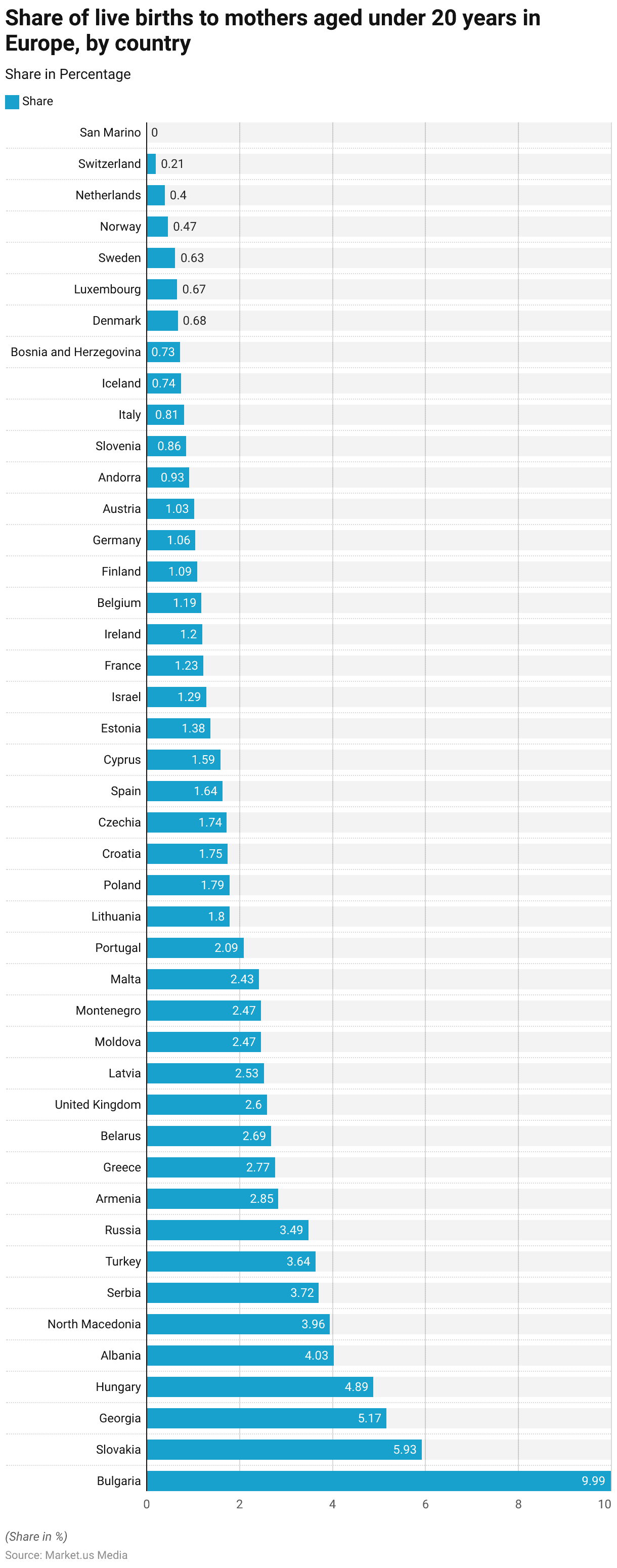
Teenage Pregnancy in Latin America and the Caribbean Statistics
Adolescent Birth Rate – By Country
- In 2020, adolescent fertility rates in Latin America and the Caribbean displayed considerable variation across countries, with Nicaragua leading the region with a rate of 102.6 births per 1,000 women aged 15-19 years.
- Honduras followed closely with 97.1 births per 1,000 adolescent women, while Mexico recorded a rate of 70.5. Panama and Guatemala reported rates of 67.8 and 63.3, respectively, while French Guiana saw 61.9 births per 1,000 adolescent women.
- Ecuador (58.4), Suriname (55.8), and Belize (55.4) also reported relatively high rates. Colombia had an adolescent fertility rate of 52.8, followed by El Salvador (51.8) and Cuba (51.1).
- In Argentina and Peru, the rates were 49.9 and 49.7, respectively. Brazil reported a slightly lower rate of 49.1, while Saint Vincent and the Grenadines had a rate of 47.2 births per 1,000 adolescent women.
- Costa Rica and Uruguay recorded much lower rates at 33.3 and 32.6, respectively, while Antigua and Barbuda reported 30.4. Chile had a rate of 22.6, and Aruba’s adolescent fertility rate was 18.5.
- Puerto Rico recorded 17 births per 1,000 women aged 15-19, while Martinique and Guadeloupe reported the lowest rates in the region at 11.2 and 10.3, respectively.
- These statistics highlight significant differences in adolescent fertility rates across the region, with Central American and Caribbean nations generally showing higher rates compared to South American countries and territories in the Caribbean.
(Source: Statista)
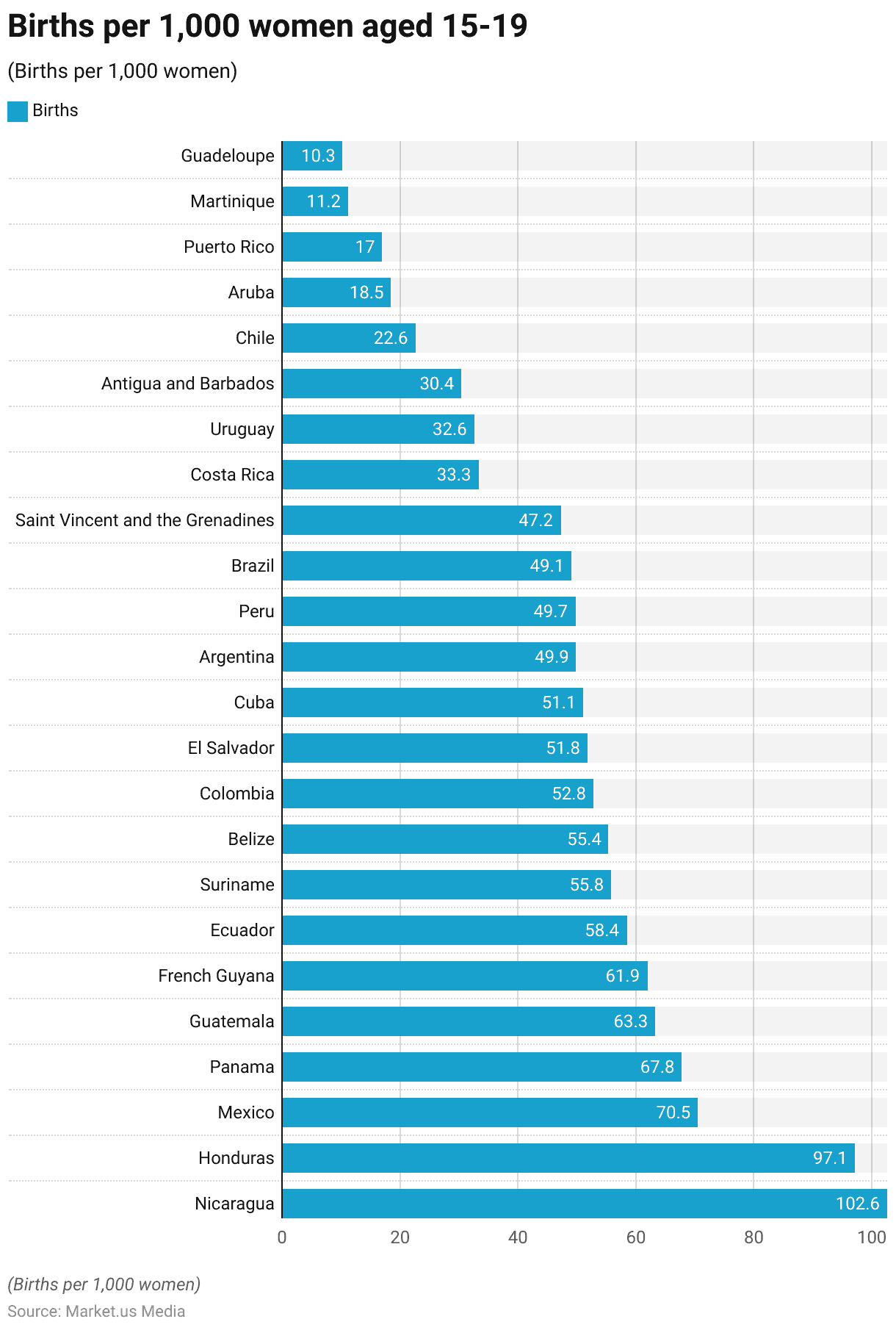
Birth Rate Before Age 18 – By Country
- As of 2018, the percentage of women aged 20 to 24 who gave birth before turning 18 varied across Latin American and Caribbean countries.
- Nicaragua had the highest share, with 28% of women in this age group giving birth before 18. Venezuela followed with 24%, while Honduras reported 22%.
- In both the Dominican Republic and Mexico, the share was 21%, indicating a significant proportion of early childbearing in these countries.
- Guatemala, Colombia, and Bolivia each had 20% of women aged 20 to 24 giving birth before 18. El Salvador reported 18%, and Belize had a share of 17%.
- In Peru and Guyana, 16% of women in this age group gave birth before 18, while Jamaica reported 15%.
- Haiti followed with 14%, and Costa Rica recorded a share of 13%. Argentina had a slightly lower share at 12%, while Barbados and Cuba reported the lowest percentages at 7% and 6%, respectively.
- These figures reflect the persistent issue of adolescent motherhood in many countries across the region, with some countries experiencing particularly high rates of early pregnancies among women under the age of 18.
(Source: Statista)

Demographic Insights
By Age
- Between 2000 and 2017, the number of teen pregnancies in the United States steadily decreased across all age groups.
- In 2000, there were 19,830 pregnancies among girls under 15 years old, 283,430 pregnancies among those aged 15-17, and 542,630 pregnancies among those aged 18-19. Over the next several years, these figures declined consistently.
- By 2005, the numbers had dropped to 15,270 for girls under 15, 239,050 for those aged 15-17, and 477,480 for those aged 18-19.
- The trend continued through the late 2000s. In 2007, pregnancies among 15- to 17-year-olds slightly increased to 247,000, while pregnancies in the youngest age group dropped to 14,520, and pregnancies among 18- to 19-year-olds rose to 506,100, the highest recorded for this age group during the period.
- From 2008 onward, a marked decline in pregnancies was observed. By 2010, pregnancies among girls under 15 dropped to 11,050, while pregnancies among those aged 15-17 fell to 190,200, and those aged 18-19 dropped to 427,790.
- By 2017, the number of pregnancies in each age group was significantly reduced: 4,460 for girls under 15, 83,680 for those aged 15-17, and 235,810 for those aged 18-19.
- This overall decrease reflects societal shifts, including better access to contraception, increased sexual health education, and a growing awareness of the importance of preventing teen pregnancies.
(Source: Statista)

By Race/Ethnicity
- Between 2007 and 2022, birth rates among U.S. teenagers aged 15-19 declined across all racial and ethnic groups.
- In 2007, the overall teen birth rate was 41.5 births per 1,000 women, with significant variations by race and ethnicity. Non-Hispanic white teens had a birth rate of 27.2, while non-Hispanic Black teens had a much higher rate of 62.
- Hispanic teens had the highest rate at 75.3, while American Indian or Alaska Native teens reported 49.4, and Asian and Pacific Islander teens had a relatively low rate of 14.8 births per 1,000.
- By 2010, the overall teen birth rate had dropped to 34.2, with non-Hispanic white teens at 23.5 and non-Hispanic Black teens at 51.5. Hispanic teens saw a decrease to 55.7, while the rates for American Indian teens fell to 38.7, and Asian and Pacific Islander teens further decreased to 10.9.
- This trend continued steadily throughout the decade, with the teen birth rate dropping to 29.4 by 2012, 26.5 by 2013, and 24.2 by 2014. In 2016, the overall rate fell to 20.3 births per 1,000, with non-Hispanic white teens at 14.3, non-Hispanic Black teens at 29.3, and Hispanic teens at 31.9.
More Insights
- American Indian teens reported 35.1 births per 1,000 women, while rates among Asian teens dropped to 3.9 for non-Hispanic Asians and 28.6 for non-Hispanic Native Hawaiians or other Pacific Islanders.
- By 2022, the overall teen birth rate had further declined to 13.6 per 1,000, with non-Hispanic white teens reporting 9.1 births per 1,000, non-Hispanic Black teens at 20.3, and Hispanic teens at 21.3.
- American Indian teens had a rate of 22.5. In contrast, non-Hispanic Asian teens reported the lowest birth rate at 1.9, and non-Hispanic Native Hawaiian or other Pacific Islander teens had a rate of 20.5.
- This data highlights a significant decline in teen birth rates across all racial and ethnic groups. Notable reductions were observed in Hispanic and non-Hispanic Black populations, which traditionally had higher rates.
- This trend reflects improved access to contraception, education on sexual health, and a general shift in societal behaviors regarding teenage pregnancies.
(Source: Statista)

Abortions Among Teenage Girls
LMICs Worldwide
- In 2019, the number of abortions among adolescent women in low- and middle-income countries was significant across several regions.
- Asia had the highest number of abortions, with 2.47 million reported.
- Africa followed with 1.96 million abortions, while Latin America and the Caribbean recorded 1.14 million.
- These figures highlight the widespread occurrence of adolescent pregnancies and abortions in these regions, reflecting the ongoing challenges related to reproductive health, access to contraception, and education for young women in low- and middle-income countries.
(Source: Statista)
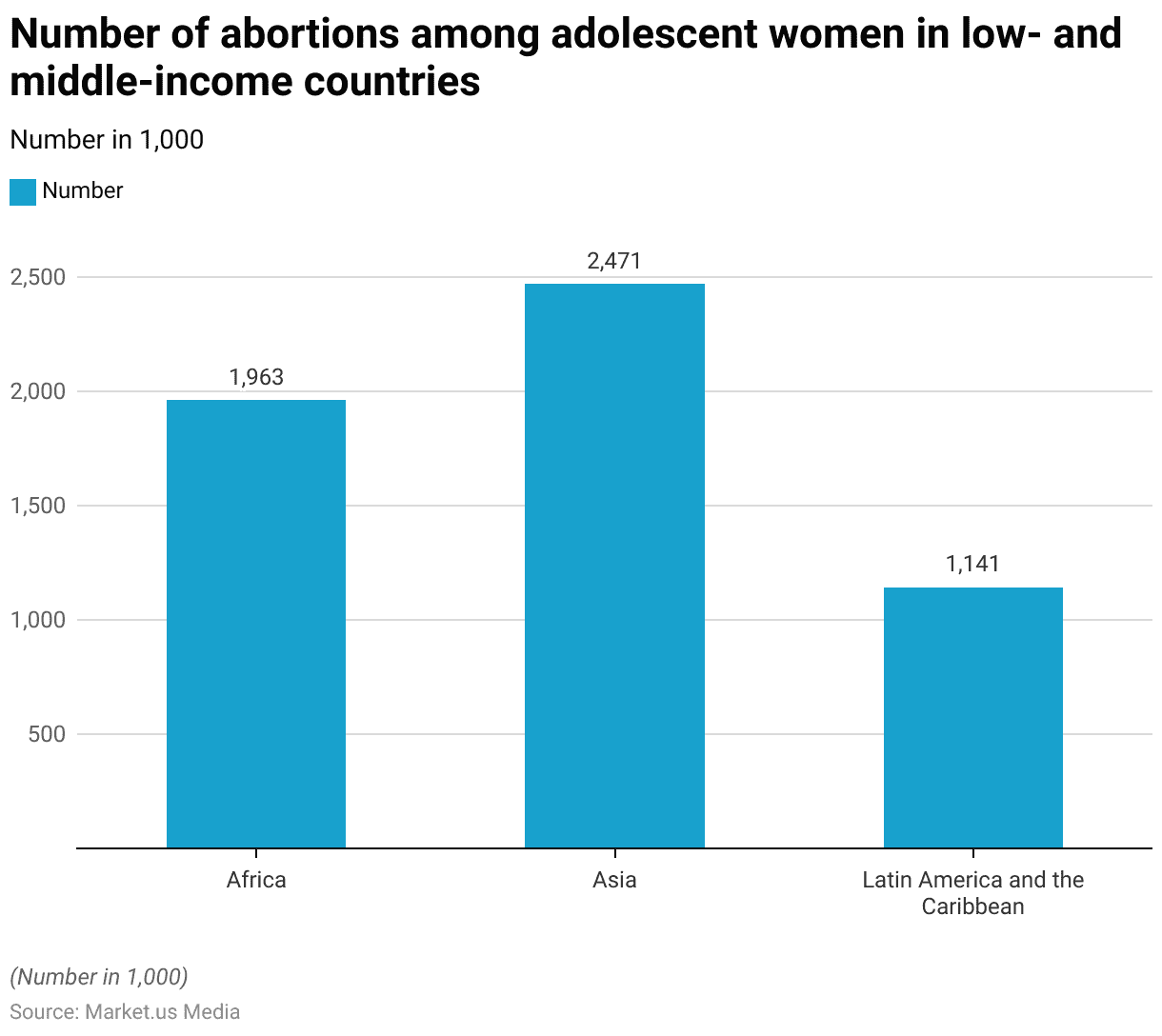
Adolescent Women – By Age
- In 2021, the number of reported abortions among adolescent women in the U.S. varied significantly by age group.
- Among those 15 years and younger, there were 1,256 reported abortions.
- The number increased to 1,842 among 15-year-olds and continued to rise with age.
- For 16-year-olds, the figure reached 3,657, while 17-year-olds accounted for 6,204 abortions.
- The number of reported abortions was notably higher among older adolescents, with 13,568 abortions recorded for 18-year-olds and 19,769 abortions among 19-year-olds.
- These figures underscore the increasing number of abortions with age within the adolescent demographic.
(Source: Statista)

Acceptability of Abortion for Teenage Pregnancy Statistics
- As of March 2024, public opinion in South Korea regarding the acceptability of abortion in cases of teenage pregnancies varied by the stage of pregnancy.
- Approximately 16% of respondents believed that abortion was not acceptable under any circumstances.
- However, the largest share, 28%, supported the legality of abortion until the 8th week of pregnancy.
- Another 15% were in favor of allowing abortion up to the 15th week, while 8% believed it should be permitted until the 23rd week.
- Interestingly, 22% of respondents supported abortion even after the 23rd week of pregnancy.
- Additionally, 12% of respondents were unsure or did not express a clear opinion on the issue.
- These results indicate a broad range of opinions on abortion in the context of teenage pregnancies, with a majority supporting abortion within the earlier stages of pregnancy.
(Source: Statista)

Birth Control Methods Deployed
- As of July 2019, a survey of young adult respondents in China revealed that condoms were the most commonly used contraceptive method, with 66.7% of respondents utilizing them to prevent pregnancy.
- Coitus interruptus, or withdrawal, was practiced by 33.8% of respondents, making it the second most popular method.
- The calendar rhythm method, used by 17.2% of participants, was also a common natural family planning technique.
- Birth control methods like oral contraceptive pills were used by 14.3% of respondents, while a smaller proportion, 6.6%, relied on surgical or hormonal methods such as vasectomy, implants, or hormonal rings for contraception.
- These findings indicate a strong preference for barrier methods like condoms among young adults in China, with other methods being used less frequently.
(Source: Statista)
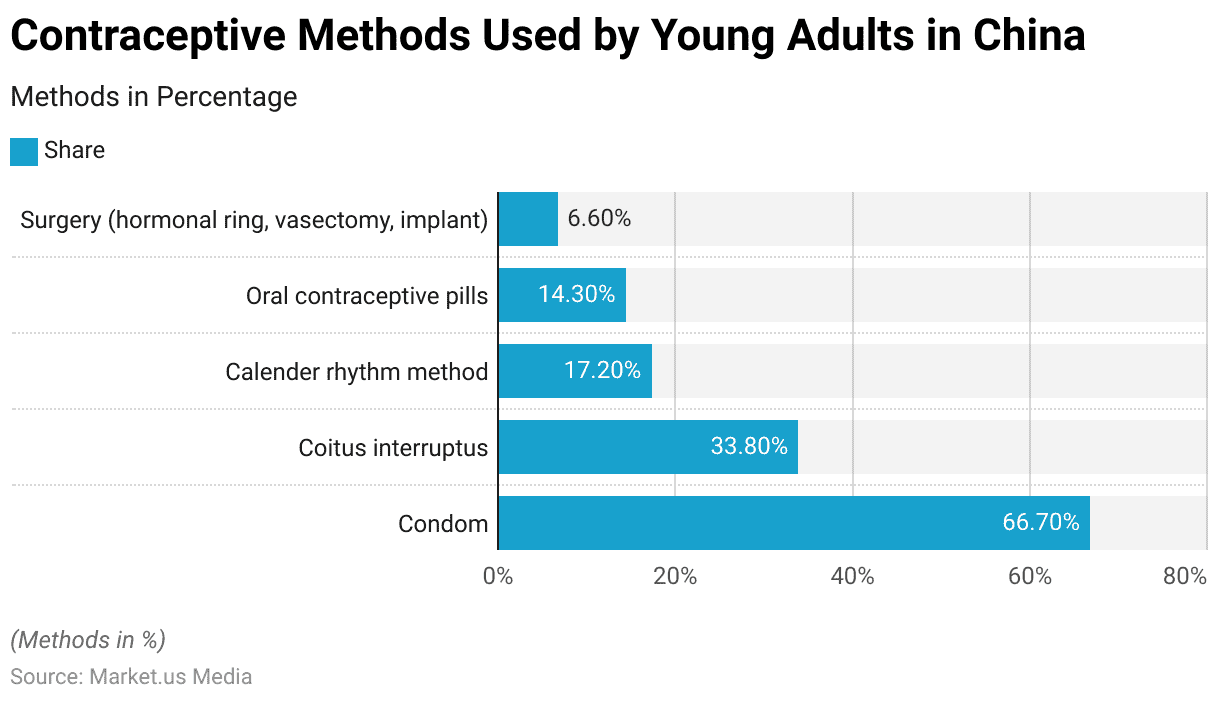
Teenage Pregnancy, Births, and Abortions Averted by Public Clinics Statistics
- In 2016, publicly funded family planning clinics in the United States played a critical role in preventing unintended adolescent pregnancies.
- These clinics helped avert 508,090 unintended pregnancies among adolescents.
- As a result, 264,180 births and 146,870 abortions were also prevented.
- These figures underscore the importance of accessible family planning services in reducing unintended pregnancies and the associated health and social outcomes for adolescents.
(Source: Statista)
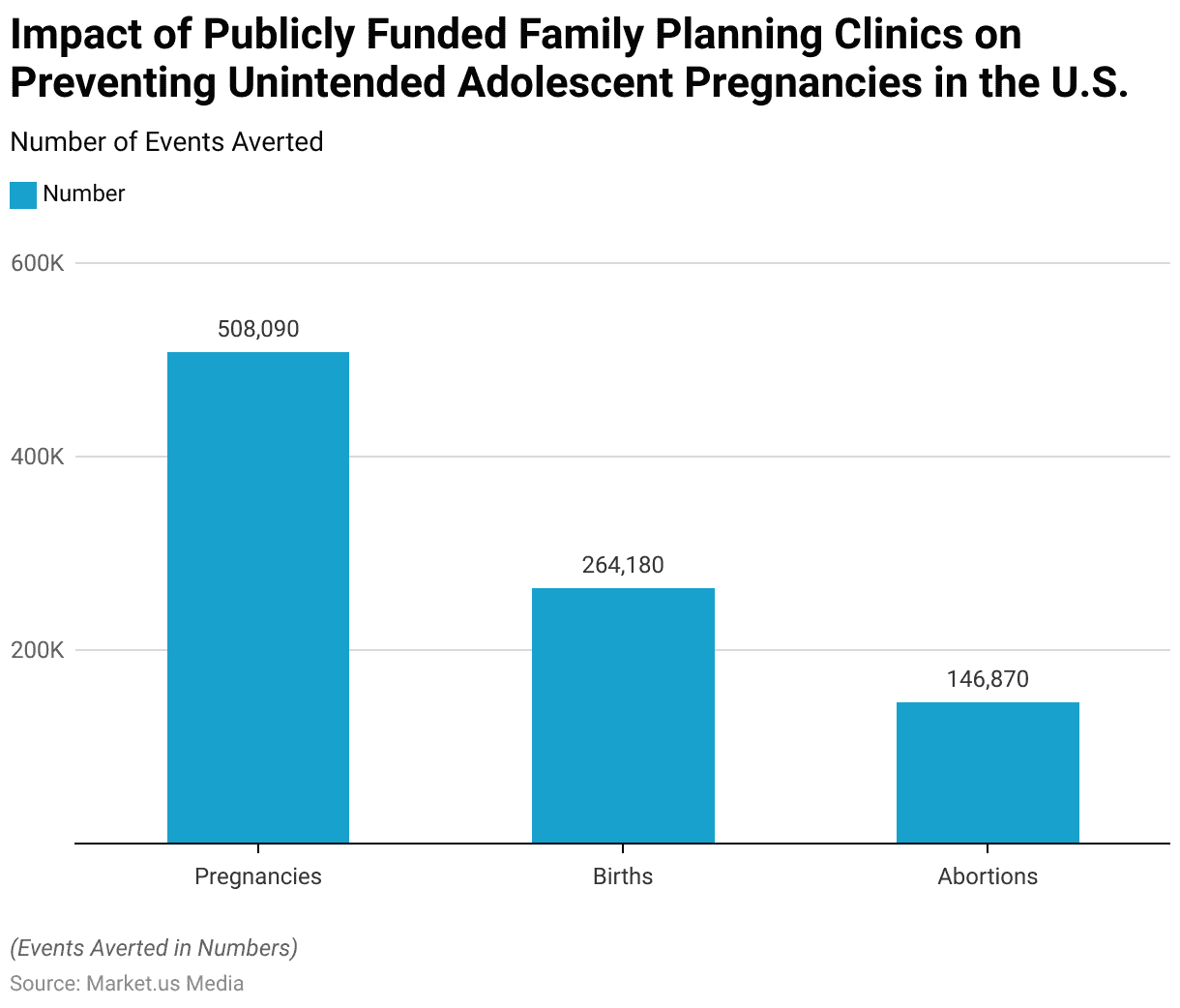
Key Investments
- Between 1998 and 2016, the U.S. federal government allocated significant funding to various programs aimed at preventing teen pregnancy.
- The Teen Pregnancy Prevention (TPP) program received $721 million, while its associated evaluation funds accounted for an additional $48 million.
- The Personal Responsibility Education Program (PREP) was allocated $515.8 million, while the largest portion of federal funds went to the Title V Abstinence Education Block Grant, which received $956.4 million.
- Community-Based Abstinence Education (CBAE) programs were also a major focus, with $705.1 million in funding, accompanied by $27 million for evaluation purposes.
- Competitive abstinence-only grants were provided with $29.7 million in funding.
- In addition, the Adolescent Family Life (AFL) program received substantial support, with $217.1 million allocated to its “care” component and $132.3 million for its “prevention” program.
- These figures reflect a broad federal commitment to addressing teen pregnancy through a variety of educational and preventive initiatives during the 1998-2016 period.
(Source: Statista)

Initiatives to Combat Teenage Pregnancy Statistics
- Initiatives to combat teenage pregnancy include comprehensive sex education, community-wide efforts, and access to reproductive health services.
- For example, the U.S. Department of Health and Human Services (HHS) runs the Teen Pregnancy Prevention Program (TPP). Which funds evidence-based initiatives aimed at reducing teen pregnancy rates, especially in high-risk communities.
- These initiatives often combine sex education, youth development, and access to clinical services.
- The Personal Responsibility Education Program (PREP) focuses on teaching both abstinence and contraception while incorporating skills like financial literacy and healthy relationships to help adolescents make informed choices.
- Additionally, community-driven programs, like the Community-Wide Teen Pregnancy Prevention Projects, work by mobilizing schools, healthcare providers, and media to spread awareness and provide services to vulnerable populations, such as African American and Latino teens.
- These programs, often evaluated for effectiveness, have shown significant success in reducing teen pregnancy rates.
(Sources: Planned Parenthood, CDC Stacks, ASPE)
Teenage Pregnancy Regulations and Statistics
- Teenage pregnancy regulations vary significantly by country, often shaped by regional cultural, social, and economic factors.
- In the U.K., for instance, the “Teenage Pregnancy Strategy” (1999-2010) helped reduce under-18 conception rates by 72%, focusing on comprehensive sex education, access to contraceptive services, and supporting young parents.
- Meanwhile, in Uganda, the “National Strategy to End Child Marriage and Teenage Pregnancy” (2022-2027) aims to combat teenage pregnancy through a multi-sectoral approach, targeting child marriage and improving girls’ access to education and healthcare.
- Globally, countries like the Philippines and Kenya have focused on raising the legal marriage age and improving access to contraceptive services. However, disparities in access remain due to socio-economic and regional factors.
- Policies worldwide often emphasize education, sexual health services, and social support to reduce teenage pregnancy, but enforcement and effectiveness vary based on local resources and political will.
(Sources: University of Bedfordshire, World Health Organization (WHO), UNICEF)
Recent Development
New Programs and Initiatives:
- U.S. Government expands teen pregnancy prevention programs: In 2023, the U.S. Department of Health and Human Services (HHS) announced a $50 million expansion of the Teen Pregnancy Prevention (TPP) Program. Focusing on evidence-based education and intervention programs aimed at reducing teen pregnancies, particularly in underserved communities.
- The UK launches digital support for teen parents: In 2023, the UK National Health Service (NHS) launched a digital support platform for teenage parents, offering resources on contraception, pregnancy health, and parenting. This platform aims to lower teen pregnancy rates and provide better support for young parents.
Partnerships and Collaborations:
- Planned Parenthood partners with schools: In 2023, Planned Parenthood expanded its partnership with schools across the U.S. Offering comprehensive sex education programs designed to reduce teen pregnancies. This initiative aims to reach 1 million students by 2025, providing education on contraception, sexual health, and healthy relationships.
- UNICEF and WHO collaboration for global awareness campaigns: In late 2023, UNICEF and the World Health Organization (WHO) launched a global campaign to reduce teenage pregnancy rates in low- and middle-income countries. The campaign focuses on increasing access to reproductive health services for teenage girls and aims to lower the global teen pregnancy rate by 15% by 2030.
Funding:
- Bill & Melinda Gates Foundation grants $80 million for reproductive health: In 2024, the Bill & Melinda Gates Foundation committed $80 million to improve reproductive health services for teenagers in Africa and South Asia. The funding will support education programs and access to contraceptives, with a focus on preventing unintended teenage pregnancies.
- United Nations Population Fund (UNFPA) secures $100 million for teenage pregnancy programs: In 2023, the UNFPA secured $100 million in funding from various international donors to expand its programs focused on reducing teenage pregnancies in sub-Saharan Africa and Latin America. The funds will be used to improve access to contraception, education, and healthcare for young women.
Technological Advancements:
- Mobile apps for sexual health education: Mobile apps are increasingly being used to educate teenagers on sexual health and contraception. By 2025, over 30% of sex education programs are expected to incorporate digital platforms and mobile apps to provide accessible and interactive education for teens.
- Telehealth for teen reproductive services: The use of telehealth for reproductive health services is rising, particularly in rural areas. In 2023, 40% of reproductive health clinics in the U.S. began offering telehealth consultations for teenagers, making it easier for them to access contraception and healthcare advice.
Market Dynamics:
- The decline in teenage pregnancy rates: The global teenage pregnancy rate has been declining. In 2023, the U.S. teen birth rate reached a historic low of 15.4 births per 1,000 women aged 15-19, representing a significant drop from previous decades. The decline is attributed to increased access to contraception and comprehensive sex education.
- Rising focus on underserved populations: Despite global improvements, some regions still face high teenage pregnancy rates. In sub-Saharan Africa, the teenage pregnancy rate remains above 90 births per 1,000 women aged 15-19, prompting international efforts to increase access to reproductive health services and education.
Conclusion
Teenage Pregnancy Statistics – Teenage pregnancy remains a significant public health issue with wide-ranging consequences for both the mother and child, including interrupted education and increased health risks.
Although teenage pregnancy rates have steadily declined due to better access to contraception and sex education, it persists in certain regions and demographic groups.
Continued efforts are needed to expand access to reproductive health services and education, particularly in underserved areas.
Publicly funded programs and community-based initiatives play a crucial role in further reducing teenage pregnancies and supporting informed decision-making among adolescents.
FAQs
Teenage pregnancy refers to pregnancy in women under the age of 20. It typically occurs in girls between the ages of 15 and 19 but can also occur in younger adolescents.
Teenage pregnancy can result from various factors, including lack of access to contraception, inadequate sex education, peer pressure, early sexual activity, and socio-economic factors such as poverty and family instability.
Teenage pregnancy can lead to increased health risks for both the mother and baby. Including higher rates of preterm birth, low birth weight, and complications during labor. Teen mothers are also more likely to experience interrupted education, economic challenges, and social stigma.
Prevention efforts include comprehensive sex education, access to contraceptive methods, promoting healthy relationships, and open communication about sexual health. Family planning clinics and public health initiatives also play a key role in reducing teen pregnancy rates.
Teenage pregnancy rates have significantly declined over the past few decades due to improved access to contraception, better sex education, and public health efforts. However, rates vary by region, socio-economic background, and access to healthcare.
Discuss your needs with our analyst
Please share your requirements with more details so our analyst can check if they can solve your problem(s)



